Broadband Anisotropy in Terahertz Metamaterial With Single-Layer Gap Ring Array
Abstract
1. Introduction
2. Structures
3. Discussions
4. Conclusions
Author Contributions
Funding
Conflicts of Interest
References
- Walther, M.; Plochocka, P.; Fischer, B.; Helm, H.; Jepsen, P.U. Collective vibrational modes in biological molecules investigated by terahertz time-domain spectroscopy. Biopolymers 2002, 67, 310–313. [Google Scholar] [CrossRef] [PubMed]
- Yang, X.; Zhao, X.; Yang, K.; Liu, Y.; Liu, Y.; Fu, W.; Luo, Y. Biomedical applications of terahertz spectroscopy and imaging. Trends Biotechnol. 2016, 34, 810–824. [Google Scholar] [CrossRef]
- Wang, S.; Xia, L.; Mao, H.; Jiang, X.; Yan, S.; Wang, H.; Wei, D.; Cui, H.; Du, C. Terahertz biosensing based on a polarization-insensitive metamaterial. IEEE Photonics Technol. Lett. 2016, 28, 986–989. [Google Scholar] [CrossRef]
- Cheon, H.; Yang, H.; Lee, S.; Kim, Y.A.; Son, J.H. Terahertz molecular resonance of cancer DNA. Sci. Rep. 2016, 6, 37103. [Google Scholar] [CrossRef] [PubMed]
- Pickwell, E.; Wallace, V.P. Biomedical applications of terahertz technology. J. Phys. D Appl. Phys. 2006, 39, R301. [Google Scholar] [CrossRef]
- Hu, H.; Yang, X.; Zhai, F.; Hu, D.; Liu, R.; Liu, K.; Sun, Z.; Dai, Q. Far-field nanoscale infrared spectroscopy of vibrational fingerprints of molecules with graphene plasmons. Nat. Commun. 2016, 7, 12334. [Google Scholar] [CrossRef] [PubMed]
- Pacebutas, V.; Biciūnas, A.; Balakauskas, S.; Krotkus, A.; Andriukaitis, G.; Lorenc, D.; Pugzlys, A.; Baltuska, A. Terahertz time-domain-spectroscopy system based on femtosecond Yb:fiber laser and GaBiAs photoconducting components. Appl. Phys. Lett. 2010, 97, 031111. [Google Scholar] [CrossRef]
- Zhang, Y.; Zhang, X.; Li, S.; Gu, J.; Li, Y.; Tian, Z.; Ouyang, C.; He, M.; Han, J.; Zhang, W. A broadband THz-TDS system based on DSTMS emitter and LTG InGaAs/InAlAs photoconductive antenna detector. Sci. Rep. 2016, 6, 26949. [Google Scholar] [CrossRef]
- Bartels, A.; Cerna, R.; Kistner, C.; Thoma, A.; Hudert, F.; Janke, C.; Dekorsy, T. Ultrafast time-domain spectroscopy based on high-speed asynchronous optical sampling. Rev. Sci. Instrum. 2007, 78, 035107. [Google Scholar] [CrossRef]
- Ying, Y.; Da Costa, R.C.; Fuchter, M.J.; Campbell, A.J. Circularly polarized light detection by a chiral organic semiconductor transistor. Nat. Photonics 2013, 7, 634–638. [Google Scholar] [CrossRef]
- Kumar, J.; Nakashima, T.; Kawai, T. Circularly polarized luminescence in chiral molecules and supramolecular assemblies. J. Phys. Chem. Lett. 2015, 6, 3445–3452. [Google Scholar] [CrossRef] [PubMed]
- Inoue, Y.; Ohmori, Y.; Kawachi, M.; Ando, S.; Sawada, T.; Takahashi, H. Polarization mode converter with polyimide half waveplate in silica-based planar lightwave circuits. IEEE Photonics Tech. Lett. 1994, 6, 626–628. [Google Scholar] [CrossRef]
- Nersisyan, S.; Tabiryan, N.; Steeves, D.M.; Kimball, B.R. Fabrication of liquid crystal polymer axial waveplates for UV-IR wavelengths. Opt. Express 2009, 17, 11926–11934. [Google Scholar] [CrossRef] [PubMed]
- Scherger, B.; Scheller, M.; Vieweg, N.; Cundiff, S.T.; Koch, M. Paper terahertz wave plates. Opt. Express 2011, 19, 24884–24889. [Google Scholar] [CrossRef] [PubMed]
- Junda, M.M.; Phillips, A.B.; Khanal, R.R.; Heben, M.J.; Podraza, N.J. Determination of conductivity anisotropy and the role of doping in single walled carbon nanotube thin films with THz spectroscopic ellipsometry. Carbon 2018, 129, 592–597. [Google Scholar] [CrossRef]
- Halir, R.; Cheben, P.; González, L.; Manuel, J.; Merenguel, S.; Darío, J.; Schmid, J.; Gonzalo, W.; Xu, D.; Wang, S.; et al. Ultra-broadband nanophotonic beamsplitter using an anisotropic sub-wavelength metamaterial. Laser Photonics Rev. 2016, 10, 1039–1046. [Google Scholar] [CrossRef]
- Lin, Y.; Cui, Y.; Ding, F.; Fung, K.; Ji, T.; Li, D.; Hao, Y. Tungsten based anisotropic metamaterial as an ultra-broadband absorber. Opt. Mater. Express 2016, 7, 606–617. [Google Scholar] [CrossRef]
- Zhu, R.; Chen, Y.; Wang, Y.; Hu, G.; Huang, G. A single-phase elastic hyperbolic metamaterial with anisotropic mass density. J. Acoust. Soc. Am. 2016, 139, 3303–3310. [Google Scholar] [CrossRef]
- Wiesauer, K.; Jordens, C. Recent advances in birefringence studies at THz frequencies. J. Infrared Millim. Terahertz Waves 2013, 34, 663–681. [Google Scholar] [CrossRef]
- Strikwerda, A.; Fan, K.; Tao, H.; Pilon, D.; Averitt, R. Comparison of birefringent electric split-ring resonator and meanderline structures as quarter-wave plates at terahertz frequencies. Opt. Express 2009, 17, 136–149. [Google Scholar] [CrossRef]
- Cong, L.; Xu, N.; Gu, J.; Singh, R.; Han, J.; Zhang, W. Highly flexible broadband terahertz metamaterial quarter-wave plate. Laser Photonics Rev. 2014, 8, 626–632. [Google Scholar] [CrossRef]
- Fan, R.H.; Zhou, Y.; Ren, X.P.; Peng, R.W.; Jiang, S.C.; Xu, D.H.; Xiong, X.; Huang, X.R.; Wang, M. Freely tunable broadband polarization rotator for terahertz waves. Adv. Mater. 2015, 27, 1201–1206. [Google Scholar] [CrossRef] [PubMed]
- Mao, H.; Xia, L.; Rao, X.; Cui, H.; Wang, S.; Deng, Y.; Wei, D.; Shen, J.; Xu, H.; Du, C. A terahertz polarizer based on multilayer metal grating filled in polyimide film. IEEE Photonics J. 2017, 8, 1–6. [Google Scholar] [CrossRef]
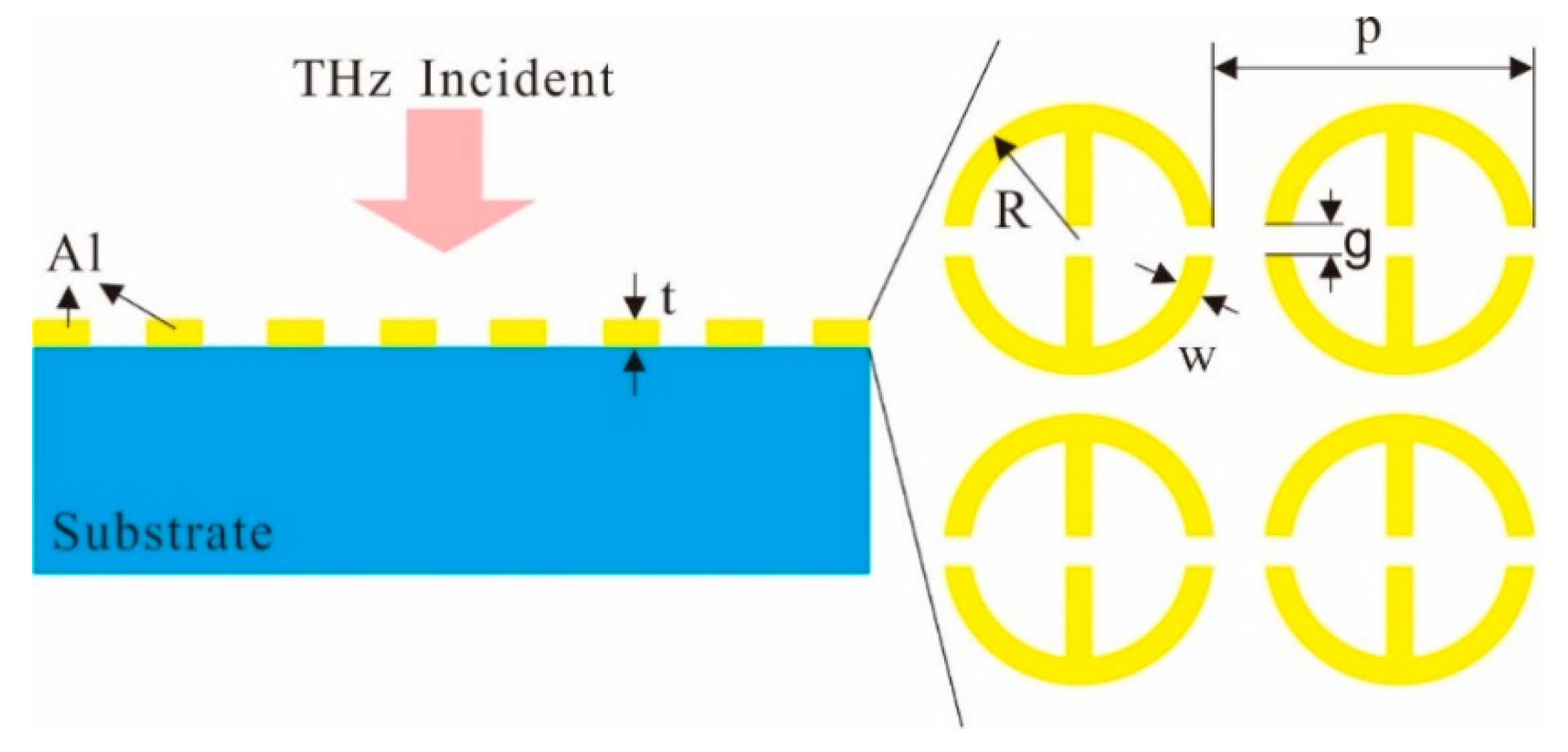
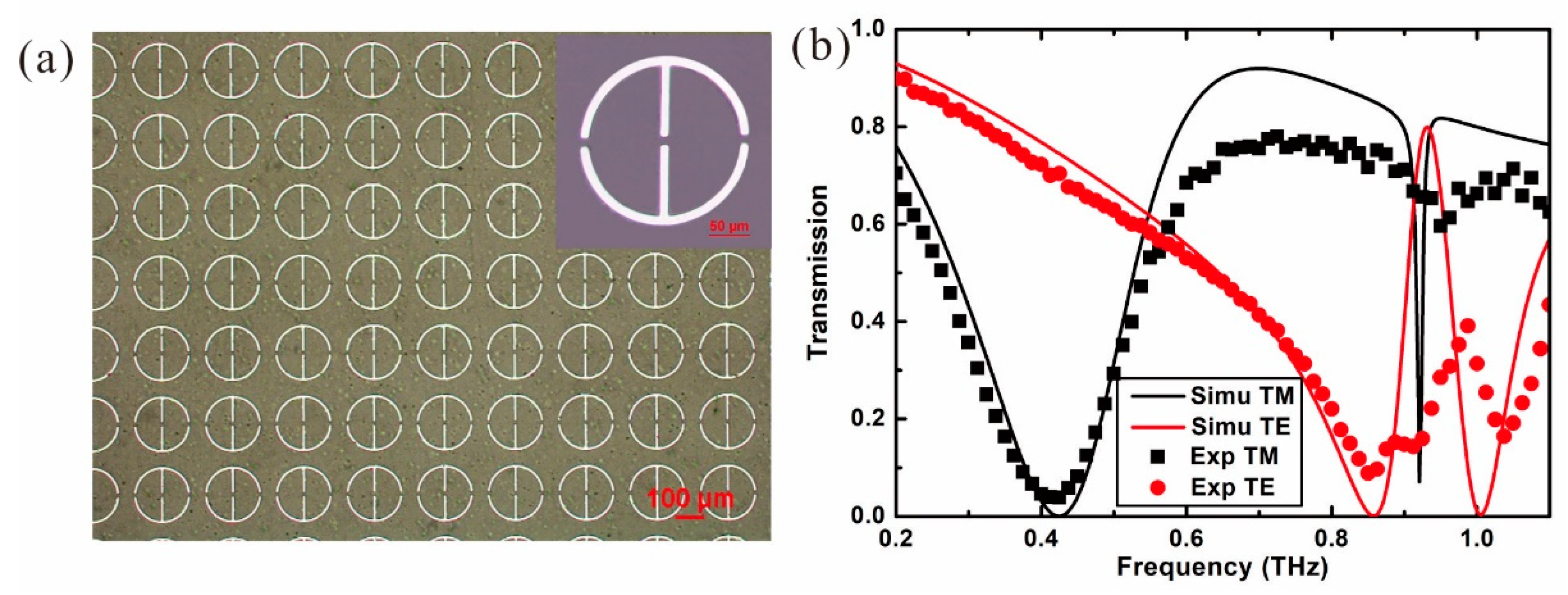
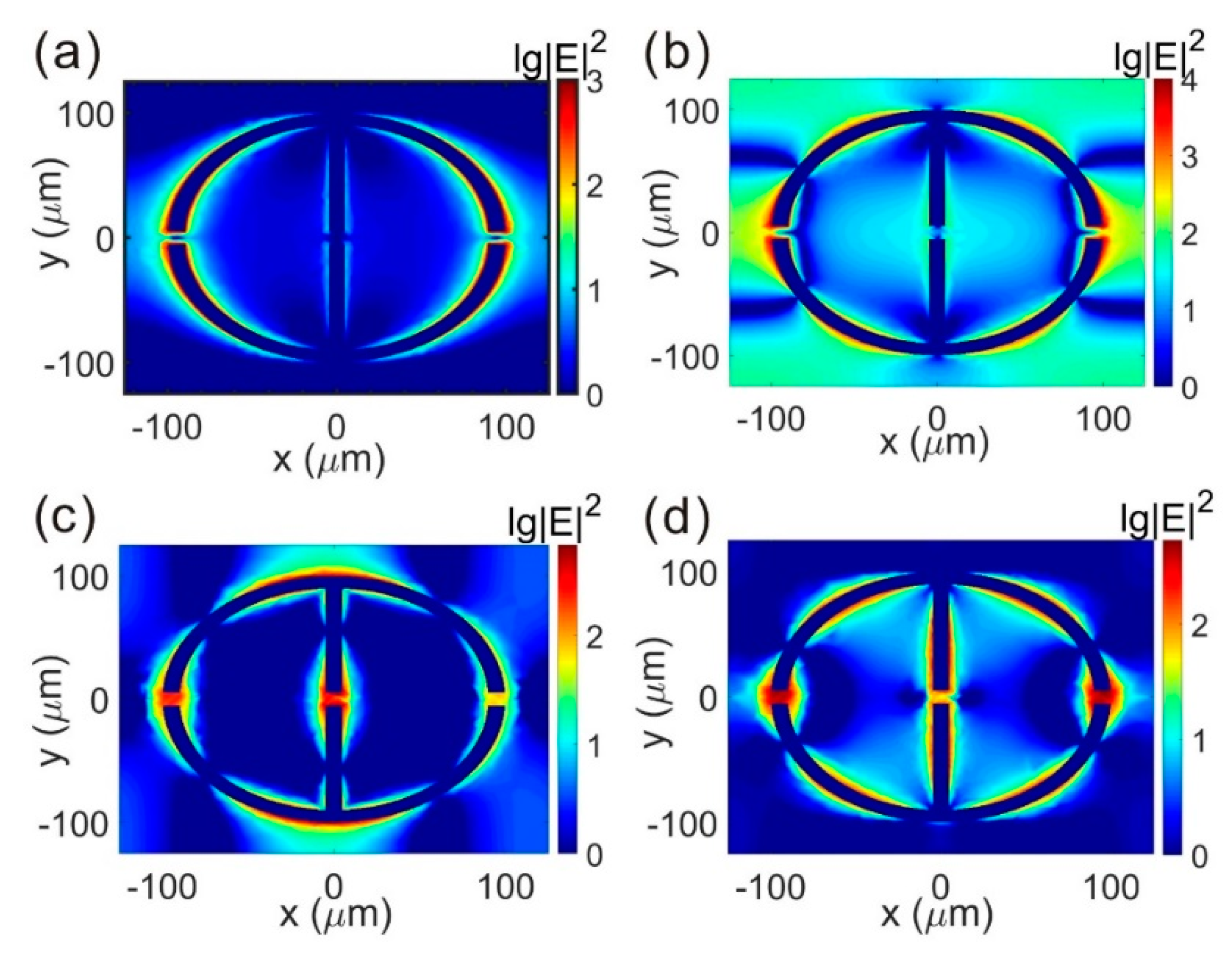
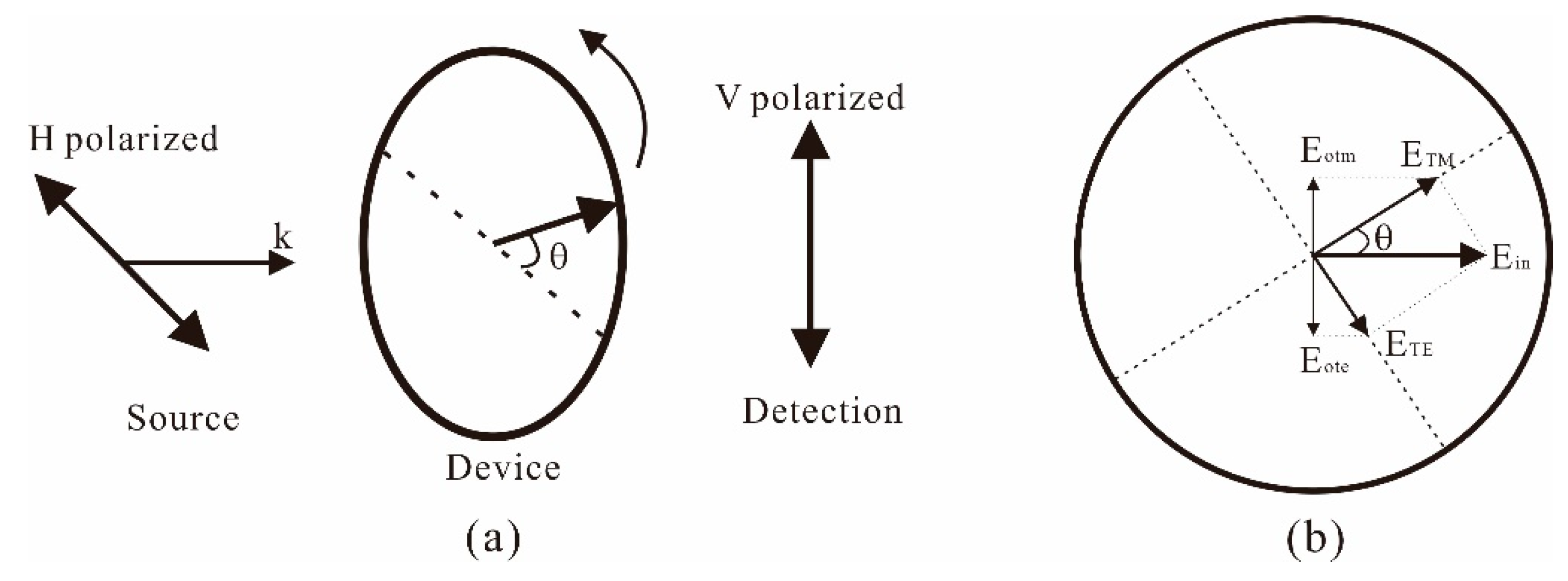
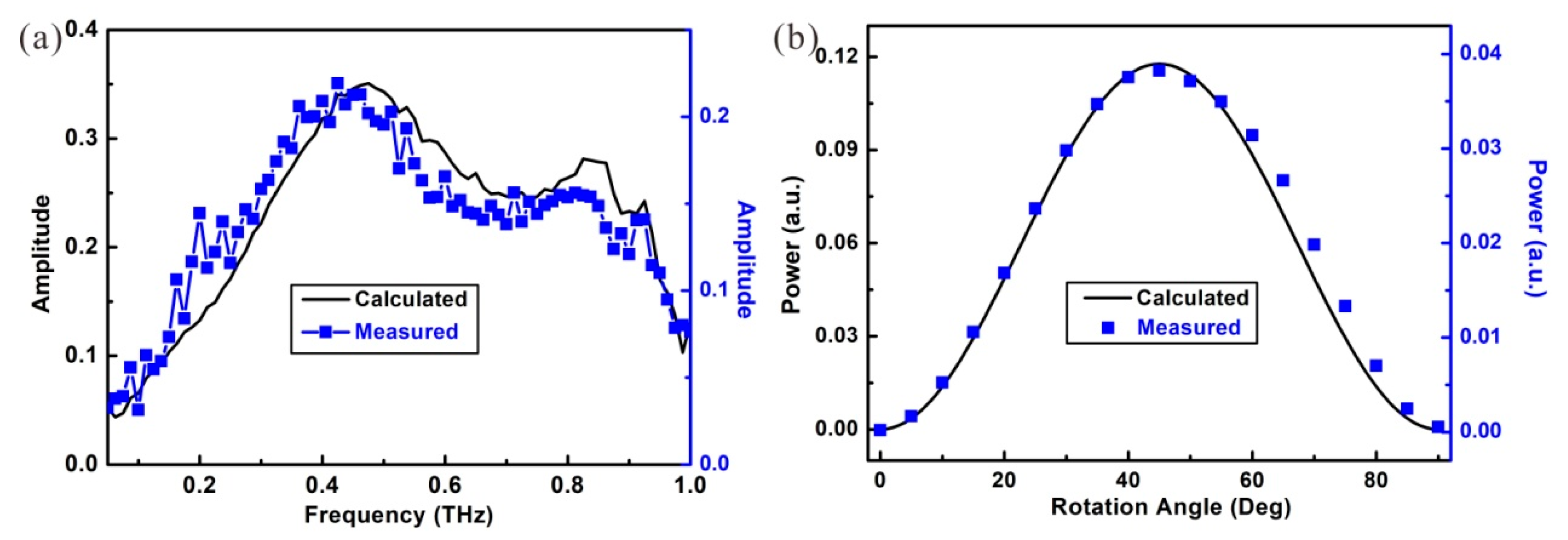
| THz Anisotropic Metamaterial | Metallic Layers | Frequency Band | Band Width |
|---|---|---|---|
| Split square ring [20] | Single-layer | 0.58–0.7 THz | 0.12 THz |
| Meanderline structure [20] | Double-layer | 0.55–0.82 THz | 0.27 THz |
| Grating [21] | Double-layer | 1.4–1.8 THz | 0.4 THz |
| Grating [22] | Three-layer | 0.15–0.42 THz | 0.27 THz |
| Our device | Single-layer | 0.275–0.835 THz | 0.56 THz |
© 2019 by the authors. Licensee MDPI, Basel, Switzerland. This article is an open access article distributed under the terms and conditions of the Creative Commons Attribution (CC BY) license (http://creativecommons.org/licenses/by/4.0/).
Share and Cite
Xia, L.; Cui, H.-L.; Zhang, M.; Dang, S.; Du, C. Broadband Anisotropy in Terahertz Metamaterial With Single-Layer Gap Ring Array. Materials 2019, 12, 2255. https://doi.org/10.3390/ma12142255
Xia L, Cui H-L, Zhang M, Dang S, Du C. Broadband Anisotropy in Terahertz Metamaterial With Single-Layer Gap Ring Array. Materials. 2019; 12(14):2255. https://doi.org/10.3390/ma12142255
Chicago/Turabian StyleXia, Liangping, Hong-Liang Cui, Man Zhang, Suihu Dang, and Chunlei Du. 2019. "Broadband Anisotropy in Terahertz Metamaterial With Single-Layer Gap Ring Array" Materials 12, no. 14: 2255. https://doi.org/10.3390/ma12142255
APA StyleXia, L., Cui, H.-L., Zhang, M., Dang, S., & Du, C. (2019). Broadband Anisotropy in Terahertz Metamaterial With Single-Layer Gap Ring Array. Materials, 12(14), 2255. https://doi.org/10.3390/ma12142255




